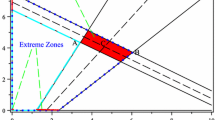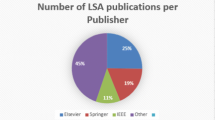Abstract
We present a constant-potential infeasible-start interior-point (INFCP) algorithm for linear programming (LP) problems with a worst-case iteration complexity analysis as well as some computational results.The performance of the INFCP algorithm is compared to those of practical interior-point algorithms. New features of the algorithm include a heuristic method for computing a “good” starting point and a procedure for solving the augmented system arising from stochastic programming with simple recourse. We also present an application to large scale planning problems under uncertainty.
Similar content being viewed by others
References
K.M. Anstreicher, “Potential reduction algorithms,” Technical Report, Department of Management Sciences, University of Iowa, Iowa City, IA, 1996 (to appear in Interior Point Methods, T. Terlaky, ed.).
J.R. Birge, “Decomposition and partitioning methods for multistage stochastic linear programs,” Operations Research, vol. 33, pp. 989–1007, 1985.
J.R. Birge, M.A.H. Dempster, H.I. Gassmann, E.A. Gunn, A.J. King, and S.W. Wallace, “A standard input format for multi-period stochastic linear programs,” Committee on Algorithms Newsletter of the Mathematical Programming Society, vol. 17, pp. 1–19, 1987.
J.R. Birge and D.F. Holmes, “Efficient solution of two-stage stochastic linear programs using interior-point methods,” Computational Optimization and Applications, vol. 1, pp. 245–276, 1992.
J. Czyzyk, R. Fourer and S. Mehrotra, “A study of the Augmented system and column-splitting approaches for solving two-stage stochastic linear programs by interior-point methods,” ORSA Journal on Computing, pp. 474–490, Fall 1995.
G. Dantzig and P.W. Glynn, “A workshop on resource planning under uncertainty for electric power systems,” Department of Operations Research, Stanford University, Stanford, California, January 21-22, 1989.
G. Dantzig and P.W. Glynn, “Parallel processors for planning under uncertainty,” Annals of Operations Research, vol. 22, pp. 1–21, 1990.
G. Dantzig and A. Madansky, “On the solution of two stage programs under uncertainty,” in Proc. of the Fourth Berkeley Symposium on Mathematics and Probability, vol. 1, University of California Press, Berkeley, California, 1961, pp. 165–176.
R. Fourer and S. Mehrotra, “Solving symmetric indefinite systems in an interior point method for linear programming,” Mathematical Programming, vol. 62, pp. 15–39, 1993.
R. M. Freund, “An infeasible-start algorithm for linear programming whose complexity depends on the distance from the starting point to the optimal solution,” Annals of Operations Research 62, pp. 29–58, 1996.
H.I. Gassmann, ”Multi-period stochastic programming,” Ph.D. Thesis, The Faculty of Commerce and Business Administration, The University of British Columbia, Vancouver, British Columbia, 1987.
P. C. Hansen, “Numerical tools for analysis and solution of Fredholm integral equations of the first kind,” Inverse Problems, vol. 8, pp. 849–872, 1992.
N. Karmarkar, “A polynomial time algorithm for linear programming,” Combinatorica, vol. 4, pp. 373–395, 1984.
M. Kojima, “Basic lemmas in polynomial-time infeasible-interior-point methods for linear programs,” Annals of Operations Research, vol. 62, pp. 1–28, 1996.
M. Kojima, N. Megiddo and S. Mizuno, “A primal-dual infeasible-interior-point algorithm for linear programming,” Mathematical Programming, vol. 61, pp. 263–280, 1993.
M. Kojima, S. Mizuno and A. Yoshise, “A polynomial time algorithm for a class of linear complementarity problems,” Mathematical Programming, vol. 44, pp. 1–26, 1989.
M. Kojima, T. Noma and A. Yoshise, “Global convergence in infeasible-interior-point algorithms,” Mathematical Programming, vol. 65, pp. 43–72, 1994.
I.J. Lustig, R.E. Marsten and D.F. Shanno, “On implementing Mehrotra's predictor-corrector interior point method for linear programming,” SIAM Journal on Optimization, vol. 2, pp. 435–449, 1992.
I.J. Lustig, R.E. Marsten and D.F. Shanno, “Computational experience with a globally convergent primal-dual predictor-corrector algorithm for linear programming,” Mathematical Programming, vol. 66, pp. 123–135, 1994.
N. Megiddo, “Pathways to the optimal set in linear programming,” in Progress in Mathematical Programming (N. Megiddo, ed.), Springer-Verlag, New York, 1988, pp. 131–158.
S. Mehrotra, “On the implementation of a primal-dual interior point method,” SIAM Journal on Optimization, vol. 2, pp. 575–601, 1992.
S. Mizuno, “Polynomiality of infeasible interior-point algorithms for linear programming,” Mathematical Programming, vol. 67, pp. 109–121, 1994.
S. Mizuno, M. Kojima, and M.J. Todd, “Infeasible-interior-point primal-dual potential-reduction algorithms for linear programming,” SIAM Journal on Optimization, vol. 5, pp. 52–67, 1995.
R.D.C. Monteiro and S.J. Wright, “A superlinear infeasible-interior-point affine scaling algorithm for LCP,” SIAM Journal on Optimization, vol. 6, pp. 1–18, 1996.
J.M. Mulvey and H. Vladimirou, “Applying the progressive hedging algorithm to stochastic generalized networks,” Annals of Operations Research, vol. 31, pp. 399–424, 1991.
Y. Nesterov, Private Communication, CORE: Belgium, 1994.
R.T. Rockafellar and R.J.-B. Wets, “Scenarios and policy aggregation in optimization under uncertainty,” Mathematics of Operations Research, vol. 16, pp. 119–147, 1991.
A. Seifi, ”A constant-potential infeasible-interior-point algorithm with application to stochastic linear programming,” Ph.D. Thesis, Department of Systems Design Engineering, University of Waterloo, Waterloo, Ontario, 1996.
M.J. Todd, “Potential-reduction methods in mathematical programming,” Technical Report 1112, School of Operations Research and Industrial Engineering, Cornell University, Ithaca, NY, 1996 (to appear in Mathematical Programming Series B).
L. Tunçel, “Constant potential primal-dual algorithms: A framework,” Mathematical Programming, vol. 66, pp. 145–159, 1994.
L. Tunçel, “On the convergence of primal-dual interior-point methods,” Computational Optimization and Applications, vol. 4, pp. 139–158, 1995.
R. Tütüncü, “An infeasible-interior-point potential-reduction algorithm for linear programming,”, Technical Report 1136, School of Operations Research and Industrial Engineering, Cornell University, Ithaca, NY, 1996.
R. Van Slyke and R. Wets, “L-shaped linear programs with application to optimal control and stochastic programming,” SIAM Journal on Applied Mathematics, vol. 17, pp. 638–663, 1969.
R. Vanderbei, “ALPO: Another Linear Program Optimizer,” ORSA Journal on Computing, vol. 5, pp. 134–146, 1993.
R.J. Vanderbei, LOQO: An interior point code for quadratic programming, Program in Statistics and Operations Research, Princeton University: Princeton, NJ, 1994.
R.J. Vanderbei and T.J. Carpenter, “Symmetric indefinite systems for interior-point methods,” Mathematical Programming, vol. 58, pp. 1–32, 1993.
R.J-B Wets, “Programming under uncertainty: the solution set,” SIAM Journal on Applied Mathematics, vol. 14, pp. 1143–1151, 1966.
R.J-B Wets, “Solving stochastic programs with simple recourse,” Stochastics, vol. 10, pp. 219–242, 1983.
R.J-B Wets, “Large scale linear programming techniques,” in Numerical Techniques for Stochastic Optimization (Y. S. Ermoliev and R.J-B Wets, eds.), Springer-Verlag: New York, 1988.
Y. Ye, M. J. Todd and S. Mizuno, “An O(√nL)-iteration homogeneous and self-dual linear programming,” Mathematics of Operations Research, vol. 19, pp. 53–67, 1994.
W. W-G. Yeh, “Reservoir management and operations models: a state-of-the-art review,” Water Resources Research, vol. 21, pp. 1797–1818, 1985.
Y. Zhang, “On the convergence of infeasible interior-point algorithms for the horizontal linear complementarity problem,” SIAM Journal on Optimization, vol. 4, pp. 208–227, 1994.
Y. Zhang, R.A. Tapia and J.E. Dennis, “On the superlinear and quadratic convergence of primal-dual interior-point linear programming algorithms,” SIAM Journal on Optimization, vol. 2, pp. 304–324, 1992.
Y. Zhang and D. Zhang, “On polynomiality of the Mehrotra-type predictor-corrector interior-point algorithms,” Mathematical Programming, vol. 68, pp. 303–318, 1995.
“CPLEX User's Guide,” CPLEX Optimization, Inc., Suite 279, Incline Village, NV, USA (http://www.cplex.com).
Y. Zhang, “LIPSOL: a MATLAB Toolkit for Linear Programming,” Department of Mathematics and Statistics, University of Maryland, Baltimore, Maryland, 1995 (available via WWW URL: http://math.umbc.edu/~yzhang).
Author information
Authors and Affiliations
Rights and permissions
About this article
Cite this article
Seifi, A., Tunçel, L. A Constant-Potential Infeasible-Start Interior-Point Algorithm with Computational Experiments and Applications. Computational Optimization and Applications 9, 107–152 (1998). https://doi.org/10.1023/A:1018343420495
Issue Date:
DOI: https://doi.org/10.1023/A:1018343420495




